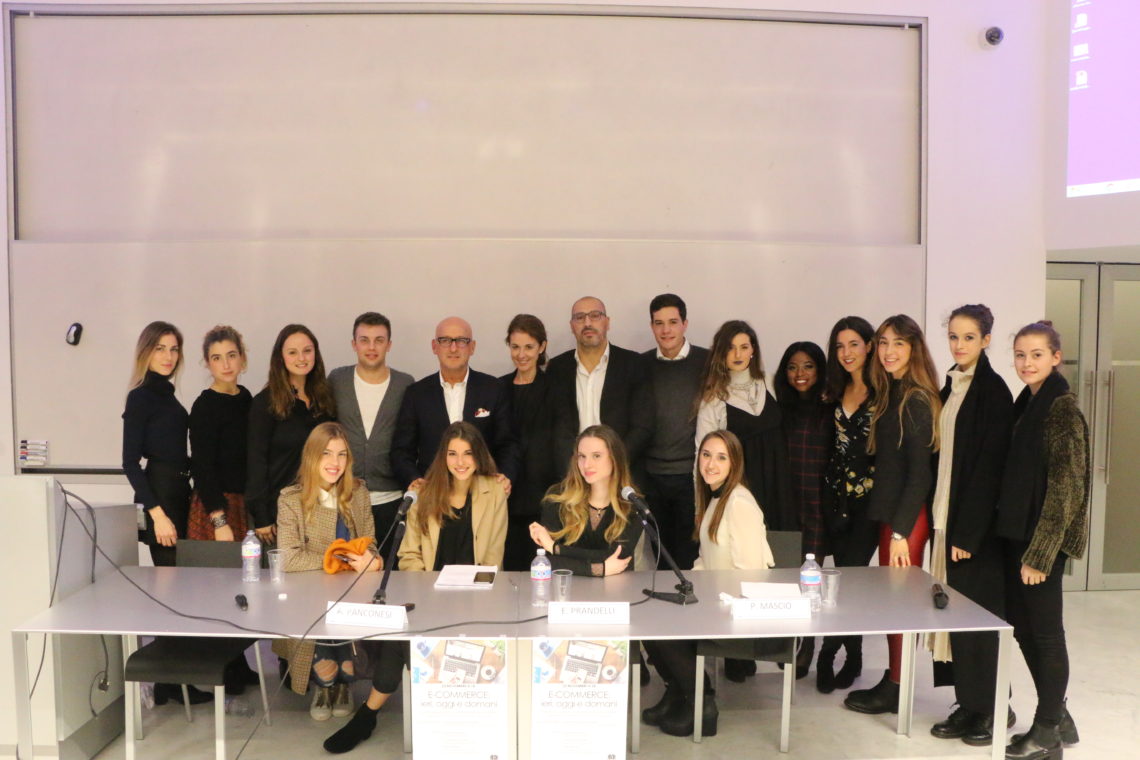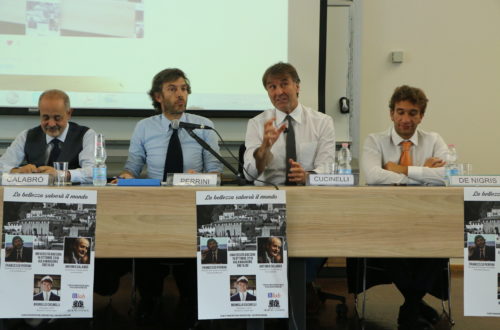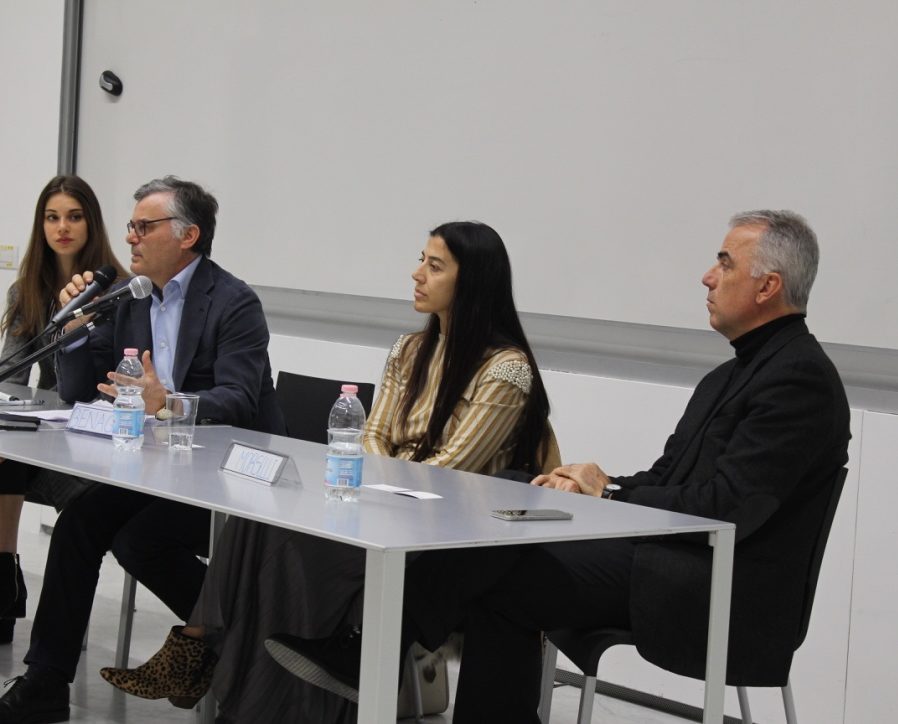A constructive moment of discussion. This is what the event held on Wednesday, 23th November at Bocconi University, hosting Andrea Panconesi – CEO of Luisa Via Roma – and Paolo Mascio – President Online Flagship Stores of Yoox Net-A-Porter Group -, chaired by Emanuela Prandelli – LVMH Associate Professor at Bocconi University – and organised by Bocconi Students for Fashion, represented. It was a moment of discussion between the guests, between them and the students, and also between two fields that, as Professor Prandelli claimed, are traditionally considered to be very apart one from the other: luxury fashion and digitalization. Moreover, it was held at Bocconi University, a place where, as Umberto Lobina – member of the events team of Bocconi Students for Fashion – said introducing the event, “many entrepreneurial activities that have made e-commerce their principal sale channel are born, and where many entrepreneurs, such as Federico Marchetti – founder of Yoox – and Paolo Mascio, studied, allowing our University to create a powerful bond with this sector, to which creation it has also contributed.”

Introducing the guests, Professor Prandelli highlighted their competence in the e-commerce field. In fact, Mr. Panconesi, grandson of Luisa Jaquin – founder of Luisa Via Roma (Florence, 1930) -, in ‘99 launched what is now one of the most important online multi brand retailers, accounting for about the 90% of the overall company’s profit. While, Mr. Mascio is President of a very influential Group in the online retail world, accounting for four websites, Yoox, Net-A-Porter, Mr Porter and The Outnet, able to reach a wide audience also thanks to their ability in elaborating data, allowing to customize the service provided. Both of these businesses show how powerful e-commerce is today, being the main source of profit for the former and the sole one for the latter. So, two business models having a strong synergy and some specific features, that have been analysed in a very interactive way, by means of direct questions and answers.
How is it possible to create a link between digital, usually perceived as democratic, accessible to everybody, and luxury, seen as aspirational, status symbol far from the common consumer dimension?
Panconesi: “I don’t think that there exists an effective contradiction between digital and luxury. If anything, a contradiction may exist between the digital world and the physical one, between the experience of entering in a shop and the one of being at home in front of a PC, or making a purchase by means of a smart phone, which is currently accounting for the 50% of the transactions. The digital world can represent both luxury and street style, from food to travels. I would not contrast digital and luxury.”

What are the specificity in shortening the distance between digital and luxury world? How is it possible to create a significant and involving experience for the digital users?
Mascio: “Firstly, the possible antithesis between digital and luxury, at least in the fashion world, doesn’t exist anymore, except for some luxury brands that refuse online sale because they believe that it is not something chic. There’s this prejudice, for example in the watchmaking industry, even if such a distance is slowly becoming shorter, and some jewellery firms. Anyway, dealing with the jewellery industry, 5 years ago Tiffany made 1 billion Euros of profit, just considering the online sale. The true fact is that people make grocery shopping on Amazon with the same easiness with which they buy a 1500€ Valentino’s bag on Valentino’s website, or on Luisa Via Roma, or Net-A-Porter. For what concerns the theme of exclusiveness, a Valentino’s bag costs 1500€ in store and 1500€ on e-store. It is not that the online purchase makes it cheaper or more democratic. It is only a matter of disposability, an additional service offered to the customer.”

What do you think about omnichannel, the integration of both a physical and online experience?
Panconesi: “Our history is the boutique one, because there exists a physical shop since 1930, even if before that date it was in another street. I must say that nowadays those two worlds are very interlaced. What is more, the digital experience has been introduced by me inside the physical space. This was due to the fact that the main problem was to educate our customers, coming daily to the physical shop, to this new World, which 15 years ago was almost unknown. Thus, the first thing we have done was introducing some screens in the shop, that in the aftermath became digital, by means of which the customer, helped by a sales assistant, concluded his/her purchase. How? We prevent sales assistants to have access to the warehouse, forcing them to choose the size of a piece of garment through a program. The fact that it worked as the e-commerce website has allowed our sales assistants to teach customers how to use the e-shop. The result was that our customers, even the non-digitalized ones, today use our website from their houses, because it was taught to them, and so they prefer it to other sites, which functioning is difficult for them to understand. This was a strategic choice that we are still developing in our shop.”
Mascio: “We have a different experience since our Company is made up of owner sites, so we are an online player and we are born as it. So, the business dimension that I’m running creates and manages flagship websites for Valentino, Armani and other luxury brands. Clearly, we don’t have a specific interest in the fact that people look for a product on Valentino’s website and then go to the shop and buy the product there, because in such a case we would not have any revenue. But from the point in time in which brands started communicating the necessity of combining the flagship website experience with the shop’s physical one, we couldn’t avoid their request. Therefore, many websites we are managing give the possibility to buy a product online and have it delivered to the shop, or return something purchased online to the physical shop, or check if a product seen online is available in shop in order to try it on, or even reserve it online for 2 days so that the customer can go to the shop and see how it fits. Just for giving an example, where there’s a shop offering the pick-up-in-store function, the 20% of the online orders coming from a 10km area are delivered to the shop. For a customer it is just a matter of practical convenience, while for the shop it is an incredible opportunity to create a stronger relationship with customers who would have never come to the physical shop, simply because they don’t like to be bothered by sales assistants, or because they don’t have time enough. Another example is that the average age of the online customers using the omnichannel service in significantly lower with respect to the online customers of the same products on the flagship website not-using the omnichannel services. As you can imagine, Saint Laurent, Valentino and Armani have a range of customers that is older, while the online customers using the omnichannel services have an age closer to 25-30 years old. Finally, in an online shop we have launched the pick-up-in-store service and during an year we kept monitoring the users. The 93% were new customers, who had never bought on the flagship website, and making their very first purchase they asked it to be delivered to the physical shop. Therefore, maybe because we manage brands and websites selling mainly in markets where the e-commerce is mature and the omnichannel diffusion is wide, such as the US one, it means that the average user perceives such tools as very easy to use, and it adds value for the user, but also for the brand that has the opportunity to attract in the shop more customers than what it would have done in such an economic period.”

Dealing with information, how are you managing the so called big data? What kind of initiatives are you developing in order to take advantage of this always richer information concerning the purchasing processes of single clients, interpret, personalise and monetise them, also with an omnichannel perspective?
Panconesi: “Every week there are new applications, new systems, new ideas. By now, it is a geometric growth. I mean, in the first years there was only Google to find a new function. Now, it is one of the many ways of doing communication, they are multiplying in an incredible way. The last news was to ask to online customers their telephone numbers. After they have registered, they receive announcements about upcoming promotions. We found that 50% of the people who required such a service, after receiving the message made a purchase. But every month there is a new way of using data.”
Mascio: “This is a theme more than wide. If firms dealt, at least, with small data, it would already be an improvement. In the sense that the fashion sector is not particularly advanced in terms of customers’ segmentation, nor it is in even more technical themes, regarding, for example, customer tracing through different devices. Today we read a transaction made through a desktop, but we don’t know if the first contact occurred after 6 visits at the website from a smartphone, unless the customer uses the same account in both the devices. It is a very complex theme, easier to be managed for online player and more complicate considering the omnichannel field. In the business I run, we offer online sale service to brands such as Valentino and Armani. Valentino, for example, has its own database of customers buying in physical shops, which has to match, interface, with the one of online customers, which we, of course, give them because its their property. But the tracing methods are not the same. It is a work that has to be continuously updated, because a customer that has always made purchases through a digital channel, tomorrow may enter into a shop becoming an omnichannel customer. In addition, facing the single customer’s personalization is very complex. For dealing with it, we singed a partnership with IBM, in order to manage all our platforms with a unique IBM’s platform. Thus, offering a personalization service on the base of, for example, customer’s country, through cookies helping distinguish different kind of customers, through brand’s social channels and so on. These allow to offer a personalized service to users, from the kind of banners and messages they receive, up to which kind of assortment they see. But it is a complex and long process, requiring plenty of time and company’s culture, due to the fact that it is very difficult to establish the logic that a website representing a brand has to be unique and equal for everyone.”
Nowadays there are many statistics about the importance of mobile phones. How much does this challenge interest you? Have you ever thought of some specific initiatives for smartphones?
Panconesi: “The initiative I mentioned before is exactly dedicated to mobile. And it is a one weak old initiative. We can say that, depending on countries, the mobile commerce accounts for the 30-50% of the online sales profit.”
Mascio: “Considering the official documents regarding the whole Group, so a company standing for 15 billion 800 million Euros all made through online sales, the traffic in all the group’s websites made through mobile devices is the 60% of the total and the value of the ordered is almost 38% of the total.”
Has YNAP ever considered the possibility of adding an offline business to its online one, or the presence of a physical shop is considered important only for monobrands? 
Mascio: “We have never stated, as a Group, the will of creating a physical store. If think it is so because both Yoox and Net-A-Porter are born with the purpose of being an online player. We have been living all the years growing remarkably, so we have never felt the need of finding additional channels, nor in term of visibility, nor of profit. Consequently, our plans are not considering a physical outlet. Although, my personal point of view is that for realities born as online player, a physical presence, not intended as an additional source of revenues, but in terms of marketing purposes and visibility, in some selected locations, can be useful. Because people still have pleasure in discovering new shops, in touching garments and, let’s say, living an experience. The fashion system lives mainly in cities such as Milan, London, Paris and New York. Opening stores in such strategic locations can give the opportunity to reach an audience usually wider that the sole online one.”
Luisa Via Roma has been the first to organise an event inviting also fashion bloggers. What have lead you, at those times, to such a choice? Did it result in an increase in awareness and sales?
Panconesi: “We chose to celebrate the first 10 years of our e-commerce initiative, 7 years ago, through an event called Firenze4ever. This party was at the beginning of the SS fashion season. We invited our friends, among which there was this new figure of the blogger. I realized that, instead of having fun during the party, those guys took pictures of the collections exposed in the shop. The result was that, in the following days, we had so much visibility that we decided to repeat such an experience six months after, and now we are at the 14th edition of this event. It is not the blogger’s festival, as it has been wrongly depicted. It is a marketing and communication initiative, which has become the greater and most important investment of Luisa Via Roma concerning online physical communication. The presence of fashion bloggers allows for an editorial shooting experience aimed at showing how an editorial piece is realized to who is outside the fashion system. This is just a little part of Firenze4ever, the main one concerns brand awareness through different channels and fields, in particular the fashion one, but also, for example, the music and contemporary art ones.”
Is it, actually, that there are still luxury brands sceptical regarding e-commerce and that consider an online catalogue useful only if used as a showroom?

Mascio: “Scepticism is not considering a very simple reality: it is not the brand that chooses what a customer does, but the customer him/herself. Scepticism is just a convenient choice to rely on the fact that things don’t evolve and that the current logics of product development are still working. On the other hand, many luxury brands are adapting to the new system, considering or already operating to reduce their physical present in order to focus on an online one. The 60% of the online retail surface all over the World has been created in the last 5-6 years, and there was an offer boom of retail spaces, and so of product, that has considerably exceeded demand evolution. Despite the fact that demand itself is decreasing because consuming models are changing, due to the fact that people have the will to enjoy an experience more than the one of own a product, it is also true that in order to own a product it is not necessary to buy it in a store. And there exist a niche of customers that is not willing to go in a physical shop. So, the scepticism is just a way through which brands are trying to convince their customers that brand-customers relationship is still in a unique direction: it is the brand that creates, defines, sells and customers buy. There has never been a traditional marketing logic, of product and commercial development of, at least, luxury brands. Finally, in the majority of the cases, for the brands of which we are managing the e-commerce, the flagship website has a profit not lower, and sometimes even higher, with respect to their main store. Thus, renouncing to a flagship website means renouncing to a huge portion of sales and customers acquisition.”
What about the second-hand e-commerce?
 Mascio: “There’s surely a thriving rental market of luxury items and accessories. For what concerns the second-hand market, some websites are blooming. But they address a very particular niche, searching only for second-hand and vintage products.”
Mascio: “There’s surely a thriving rental market of luxury items and accessories. For what concerns the second-hand market, some websites are blooming. But they address a very particular niche, searching only for second-hand and vintage products.”
Prandelli: “I believe that the true challenge here is linked to the fake. What is fundamental is developing some practices to certify the product’s authenticity. There are some tracing means, some sites implement additional fees to do so, other do the same only for products over a threshold, in order to protect both the parties.”
Panconesi: “In fact, another aspect that needs constant monitoring in our business is the returns one. Sometimes it occurs that the certified product we deliver, coming directly from the firms, is not returned to us, but replaced with a fake. It is why we are organized with a system of tracing and labelling, to immediately recognise the fake return.”
What about start-ups?
 Mascio: “I believe that a very important innovation could deal with a standardized technology for reducing returns. There are plenty of start-ups and already affirmed businesses dealing with similar services, suggesting garments and sizes with respect to each person body and shapes. Anyway, nowadays it does not exist a sort of dominating technology allowing for a correct size choice, solving perspective customers’ doubts and convincing them to finalize the purchase. This, in fact, is a problem mainly for older customers, for which e-commerce is still a barrier. Currently, there’s an increasing returns trend, because people are becoming used to the process and so they feel more comfortable with online purchasing.”
Mascio: “I believe that a very important innovation could deal with a standardized technology for reducing returns. There are plenty of start-ups and already affirmed businesses dealing with similar services, suggesting garments and sizes with respect to each person body and shapes. Anyway, nowadays it does not exist a sort of dominating technology allowing for a correct size choice, solving perspective customers’ doubts and convincing them to finalize the purchase. This, in fact, is a problem mainly for older customers, for which e-commerce is still a barrier. Currently, there’s an increasing returns trend, because people are becoming used to the process and so they feel more comfortable with online purchasing.”
Do you perceive as a future opportunity the sale through channels such as social networks? How will you face this challenge if it concretize? 
Panconesi: “The investment we made on social networks is significant and increasing. It is an opportunity, but it is essential to be the first to take advantage of it. Anyway, I strongly believe that instead of trying to gain a greater market share through new channels, there’s the need to focus on current customers.”
Mascio: “Some experiments of direct purchases through social networks have already been made in the past years, such as the Asos one in collaboration with Facebook. But the outcomes were unsatisfactory. The reason is because the aim of a person using social networks is not the one of a buyer. Instagram has made an agreement with American brands to allows for direct links between a post and the brand’s e-shop platform. I think it just witnesses the will of the socials to create business models sustainable in time, not the users’ need for this innovation. Social don’t have customers, they have users. They are definitely two different things. It would be expensive to realize such a switch, from managing users to managing customers.”
Which are the main operating difficulties to be managed in the e-commerce business? 
Mascio: “From an operational stand point, the main problems are logistics and managing such big amounts of products that are mainly seasonal, which means they go out of fashion very fast. Another important consideration is that e-commerce is not a particularly profitable business. We are a listed company and, 4 years before the merger, we multiplied our top line, our total sales by 4-5, but our percentage EBITDA remained stable for 4 years in a row, at about 9%. The most successful fashion companies have EBITDA margins that are 30% or even higher. So, it is difficult, as it implies working with very squeezed margins, due to the fact that it is a very expensive business. It is about managing warehouses, deliveries, customers and so on. There’s much operational complexity behind.”
Therefore, the challenge is, as Professor Prandelli said, to be able to assess the change in customers’ needs and their approach to purchases. Thus, talking about luxury companies, find a way to offer an adequate experience to customers, managing all the aspects that have been discussed during the conference.

See an exclusive interview to Paolo Mascio in collaboration with BocconiTV here.
Article by Laura Gaudioso, photos by Yancong Wang





